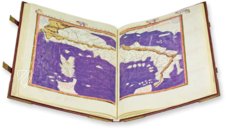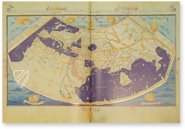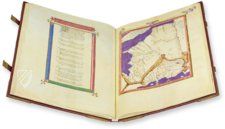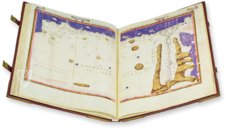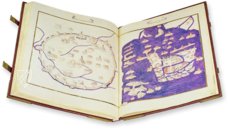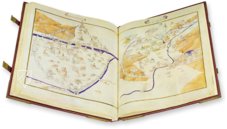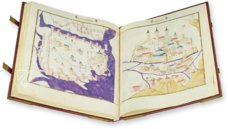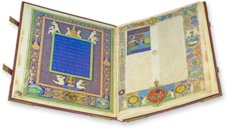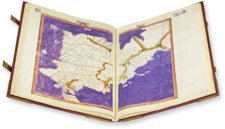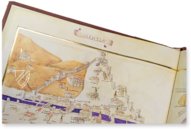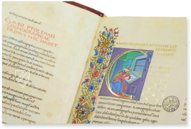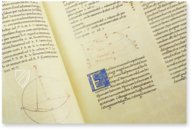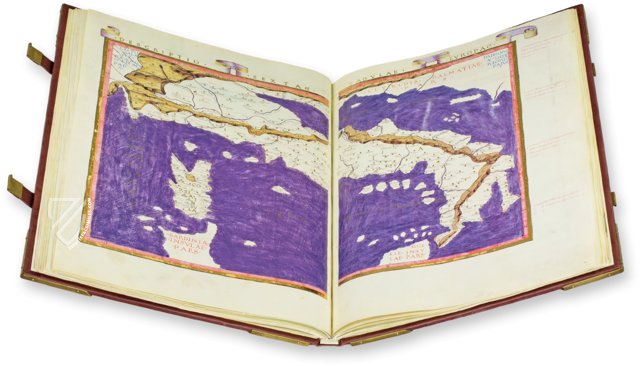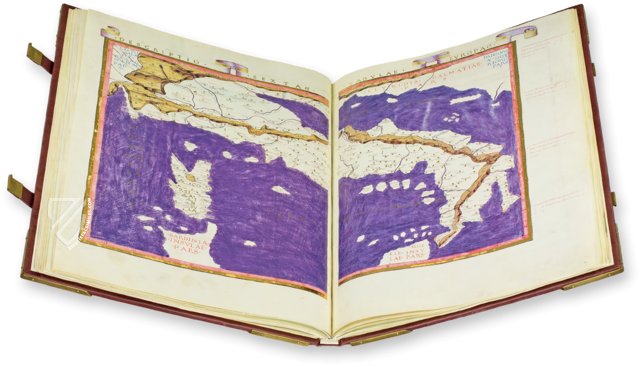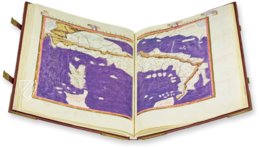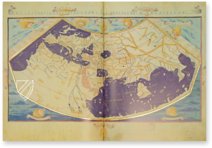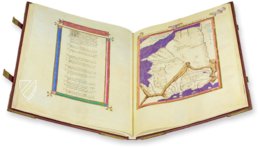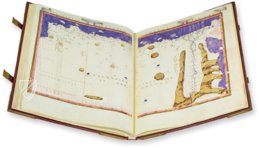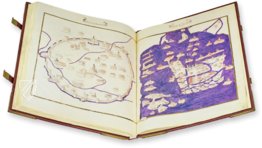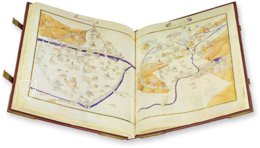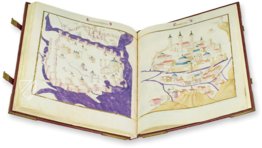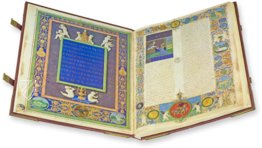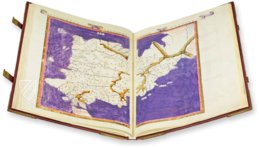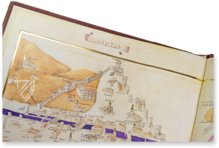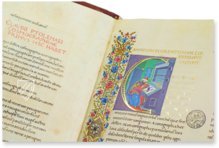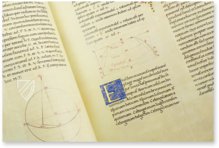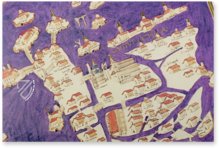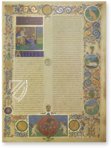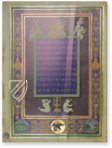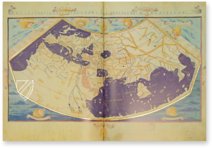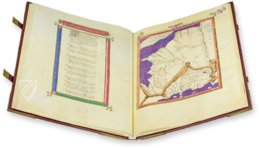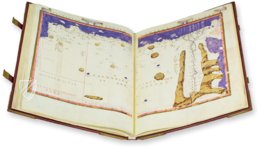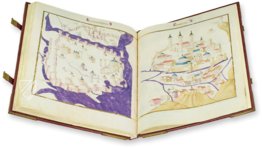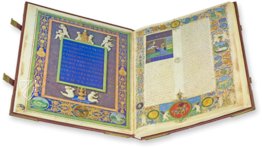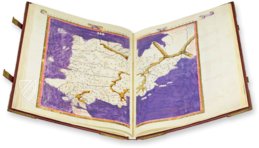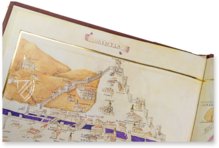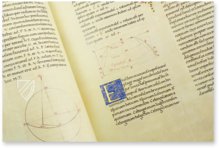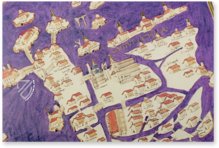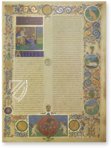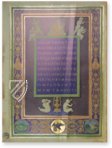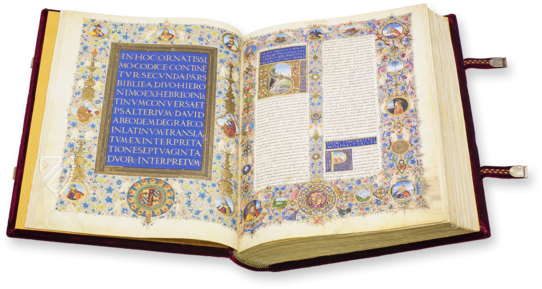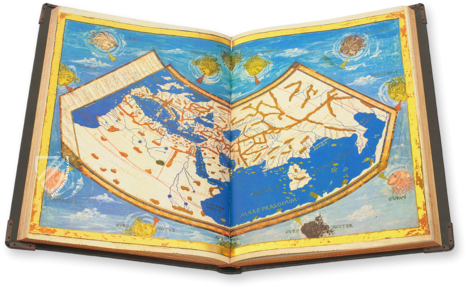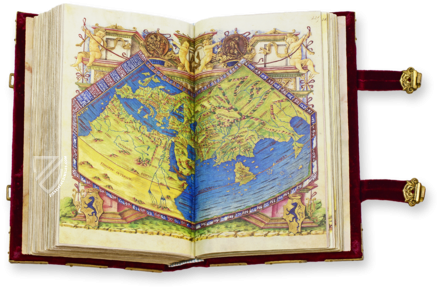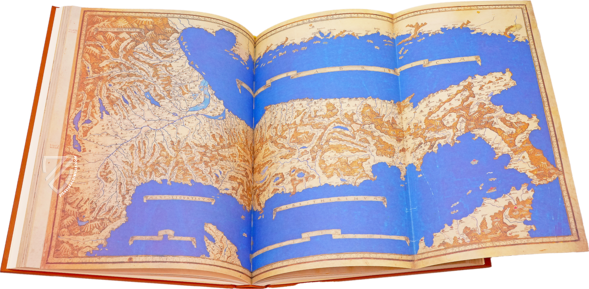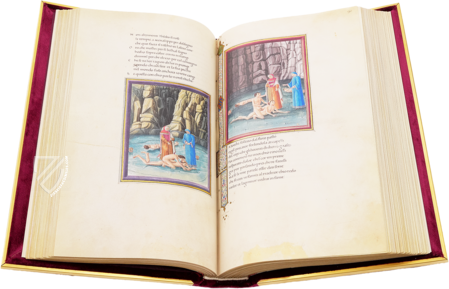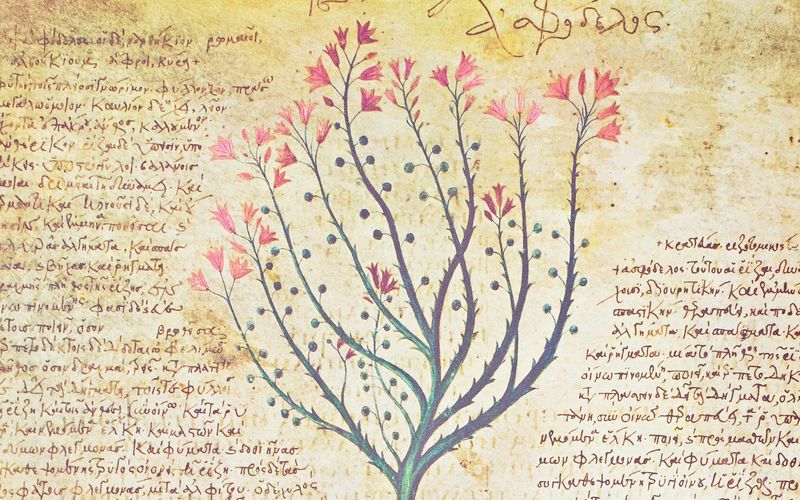Cosmography of Claudius Ptolemy
(3,000€ - 7,000€)
The Cosmography of Claudius Ptolemy is a world atlas that originates from Italy in 1472. It is a refashioning of the cosmography by the ancient Greek scholar Ptolemy and contains 44 geographically correct maps, 29 of which span a double page. Many text pages are elaborately adorned with numerous colorful and golden miniatures and depictions in bordures. Like all cosmographic works, it combines geography, geology, and astrology as well as addressing the historical, spiritual, and moral aspects of the medieval worldview. The large format maps and other colorful and gilded depictions were designed by talented artists of the Italian Renaissance including Francesco Rosselli and Pietro del Massaio. This magnificent manuscript was commissioned in 1471 by Federico da Montefelatro, Duke of Urbino, who was a famous statesman, general, and humanist patron of the arts.
Cosmography of Claudius Ptolemy
The cosmography was the science of description of the Earth and outer space in the Middle Ages. Cosmographic works were devoted to geography, geology, and astrology and were concerned with historical, spiritual, and moral aspects of the medieval worldview. The first globes and cartographical depictions of our Earth are attributable to medieval cosmographic works. An especially beautiful version of these teachings is the Cosmography of Claudius Ptolemy. The work originates from the second century after Christ and was lost for over 1,000 years, until it reemerged during the early Italian Renaissance. It contains 44 maps, of which 29 fill a double page. Furthermore, there are numerous colorful and golden miniatures and depictions in bordures that decorate the margins of the pages.
The Polymath Claudius Ptolemy
Ptolemy was a Greek mathematician, geographer, astronomer, astrologer, music theorist, and philosopher. His works on astronomy, geography, and astrology were regarded in Europe as important, comprehensive collections of data and standard scientific texts until the early modern period. His earlier world atlas revolutionized the geographic perceptions of the Renaissance. Claudius Ptolemy created maps of the world he knew and followed mathematical principals, which founded modern cartography. He introduced the system of longitude and latitude. His cosmography was given new life by some of the most gifted Renaissance artists.
The Cosmography in a New Garment
The important didactic piece originally spanned eight scrolls. These were incorporated into a single codex during the refashioning. The new edition was commissioned in 1471 by Duke Federico da Montefelatro. This manuscript is divided into eight books, exceedingly talented masters inscribed and illustrated the pages. Applications of various colors and gold make treasures of the special miniatures. Scientific insights were made understandable through charming pictures. As such, these early cartographical achievements succeed in impressing their beholder up to today.
Codicology
- Alternative Titles
- Cosmographia des Claudius Ptolemaeus
Cosmographia des Claudius Ptolemäus
Carta Tolemaica di Pietro Del Massaio - Type
- Map on parchment
- Size / Format
- 270 pages / 59.3 × 43.5 cm
- Origin
- Italy
- Date
- 1472
- Epochs
- Style
- Genre
- Language
- Illustrations
- 44 maps including 29 double-pages; numerous illustrations and decorative borders
- Content
- Claudius Ptolemaeus' World Atlas with a Latin translation by Iacopo d'Angelo da Scarperia
- Patron
- Federico da Montefeltro, Duke of Urbino (1448–1482)
- Artist / School
- Claudius Ptolemy (ca. 100 – ca. 170) (author)
Francesco Rosselli (1445 – before 1513) (illuminator)
Pietro del Massaio (1420 – 80) (illuminator)
Ugo de Comminelli (scribe)
Cosmography of Claudius Ptolemy
Presentation Miniature
The opening pages of the manuscript include this wonderful miniature showing the presentation of the codex to the Pope by Federico de Montefeltro. What is odd is that the text identifies him as Alexander III – ALEXANDRU TERTIUM SVMMVM PONTIFICEM – who died 241 years before the famous condottiero, art patron, and Duke of Urbino was born. Whether Alexander III is depicted here because of some familial connection or personal admiration on behalf of Federico, the tiny scene is extraordinary.
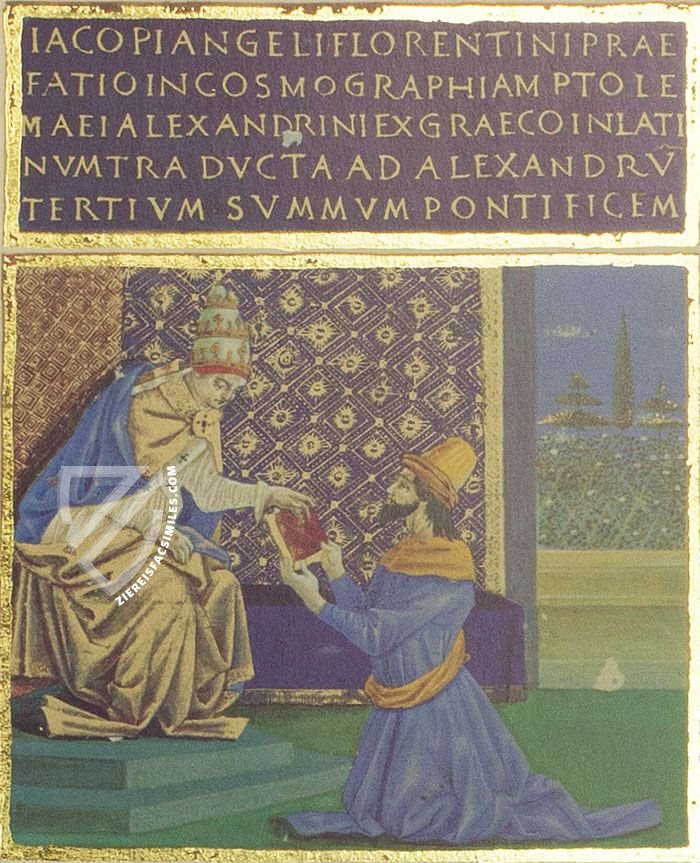
Cosmography of Claudius Ptolemy
Depiction of Rome
Medieval Rome, named in a banderole with gold ink, is presented here in an elegantly simple frame that is also rendered in polished gold. The miniature depicts the seven hills of Rome, the Tiber in dark blue, and the remnants of the aqueduct, in addition to various churches and monuments from antiquity that are labelled in a minute hand.
The most recognizable landmarks include the Colosseum, the Pyramid of Cestius, which is depicted incorporated into the Aurelian Walls that ring the city, and the Pyramid of Romulus, which was quarried for marble used in the construction of St. Peter’s Basilica. Elegant shades of pink give the miniature a dreamy aesthetic, and the spires of various churches are highlighted with gold leaf.
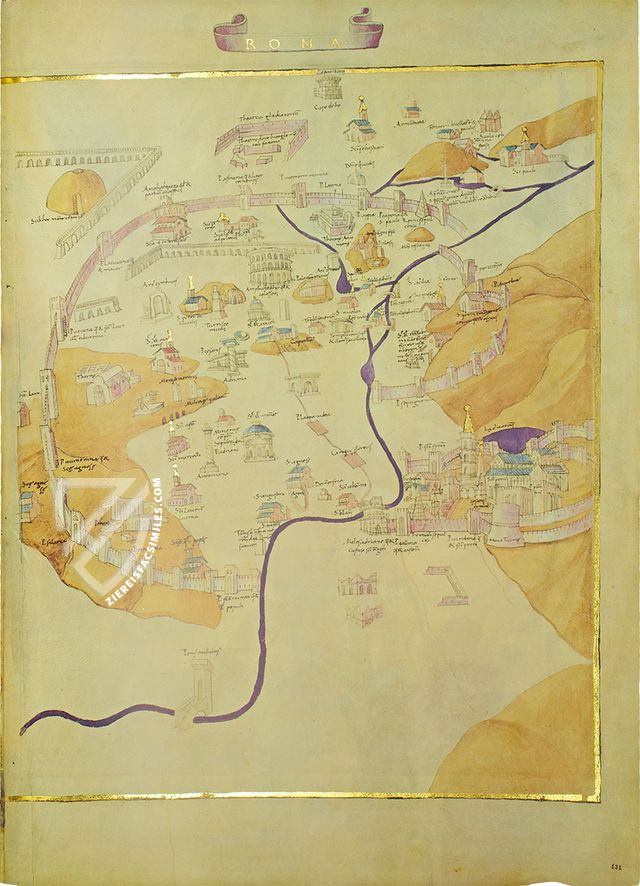
#1 Cosmographia des Claudius Ptolemaeus (Deluxe Edition)
Languages: German
(3,000€ - 7,000€)
#2 Cosmographia des Claudius Ptolemaeus (Normal Edition)
Languages: German
(3,000€ - 7,000€)
- Treatises / Secular Books
- Apocalypses / Beatus
- Astronomy / Astrology
- Bestiaries
- Bibles / Gospels
- Chronicles / History / Law
- Geography / Maps
- Saints' Lives
- Islam / Oriental
- Judaism / Hebrew
- Single Leaf Collections
- Leonardo da Vinci
- Literature / Poetry
- Liturgical Manuscripts
- Medicine / Botany / Alchemy
- Music
- Mythology / Prophecies
- Psalters
- Other Religious Books
- Games / Hunting
- Private Devotion Books
- Other Genres
- Afghanistan
- Armenia
- Austria
- Belgium
- Belize
- Bosnia and Herzegovina
- China
- Colombia
- Costa Rica
- Croatia
- Cyprus
- Czech Republic
- Denmark
- Egypt
- El Salvador
- Ethiopia
- France
- Germany
- Greece
- Guatemala
- Honduras
- Hungary
- India
- Iran
- Iraq
- Israel
- Italy
- Japan
- Jordan
- Kazakhstan
- Kyrgyzstan
- Lebanon
- Liechtenstein
- Luxembourg
- Mexico
- Morocco
- Netherlands
- Palestine
- Panama
- Peru
- Poland
- Portugal
- Romania
- Russia
- Serbia
- Spain
- Sri Lanka
- Sweden
- Switzerland
- Syria
- Tajikistan
- Turkey
- Turkmenistan
- Ukraine
- United Kingdom
- United States
- Uzbekistan
- Vatican City
- A. Oosthoek, van Holkema & Warendorf
- Aboca Museum
- Ajuntament de Valencia
- Akademie Verlag
- Akademische Druck- u. Verlagsanstalt (ADEVA)
- Aldo Ausilio Editore - Bottega d’Erasmo
- Alecto Historical Editions
- Alkuin Verlag
- Almqvist & Wiksell
- Amilcare Pizzi
- Andreas & Andreas Verlagsbuchhandlung
- Archa 90
- Archiv Verlag
- Archivi Edizioni
- Arnold Verlag
- ARS
- Ars Magna
- ArtCodex
- AyN Ediciones
- Azimuth Editions
- Badenia Verlag
- Bärenreiter-Verlag
- Belser Verlag
- Belser Verlag / WK Wertkontor
- Benziger Verlag
- Bernardinum Wydawnictwo
- BiblioGemma
- Biblioteca Apostolica Vaticana (Vaticanstadt, Vaticanstadt)
- Bibliotheca Palatina Faksimile Verlag
- Bibliotheca Rara
- Boydell & Brewer
- Bramante Edizioni
- Bredius Genootschap
- Brepols Publishers
- British Library
- C. Weckesser
- Caixa Catalunya
- Canesi
- CAPSA, Ars Scriptoria
- Caratzas Brothers, Publishers
- Carus Verlag
- Casamassima Libri
- Centrum Cartographie Verlag GmbH
- Chavane Verlag
- Christian Brandstätter Verlag
- Circulo Cientifico
- Club Bibliófilo Versol
- Club du Livre
- CM Editores
- Collegium Graphicum
- Collezione Apocrifa Da Vinci
- Comissão Nacional para as Comemorações dos Descobrimentos Portugueses
- Coron Verlag
- Corvina
- CTHS
- D. S. Brewer
- Damon
- De Agostini/UTET
- De Nederlandsche Boekhandel
- De Schutter
- Deuschle & Stemmle
- Deutscher Verlag für Kunstwissenschaft
- DIAMM
- Droz
- E. Schreiber Graphische Kunstanstalten
- Ediciones Boreal
- Ediciones Grial
- Ediclube
- Edições Inapa
- Edilan
- Editalia
- Edition Deuschle
- Edition Georg Popp
- Edition Leipzig
- Edition Libri Illustri
- Editiones Reales Sitios S. L.
- Éditions de l'Oiseau Lyre
- Editions Medicina Rara
- Editorial Casariego
- Editorial Mintzoa
- Editrice Antenore
- Editrice Velar
- Edizioni Edison
- Egeria, S.L.
- Eikon Editores
- Electa
- Emery Walker Limited
- Enciclopèdia Catalana
- Eos-Verlag
- Ephesus Publishing
- Ernst Battenberg
- Eugrammia Press
- Extraordinary Editions
- Fackelverlag
- Facsimila Art & Edition
- Facsimile Editions Ltd.
- Facsimilia Art & Edition Ebert KG
- Faksimile Verlag
- Feuermann Verlag
- Folger Shakespeare Library
- Franco Cosimo Panini Editore
- Friedrich Wittig Verlag
- Fundación Hullera Vasco-Leonesa
- G. Braziller
- Gabriele Mazzotta Editore
- Gebr. Mann Verlag
- Gesellschaft für graphische Industrie
- Getty Research Institute
- Giovanni Domenico de Rossi
- Giunti Editore
- Graffiti
- Grafica European Center of Fine Arts
- Guido Pressler
- Guillermo Blazquez
- Gustav Kiepenheuer
- H. N. Abrams
- Harrassowitz
- Harvard University Press
- Helikon
- Hendrickson Publishers
- Henning Oppermann
- Herder Verlag
- Hes & De Graaf Publishers
- Hoepli
- Holbein-Verlag
- Houghton Library
- Hugo Schmidt Verlag
- Idion Verlag
- Il Bulino, edizioni d'arte
- ILte
- Imago
- Insel Verlag
- Insel-Verlag Anton Kippenberger
- Instituto de Estudios Altoaragoneses
- Instituto Nacional de Antropología e Historia
- Introligatornia Budnik Jerzy
- Istituto dell'Enciclopedia Italiana - Treccani
- Istituto Ellenico di Studi Bizantini e Postbizantini
- Istituto Geografico De Agostini
- Istituto Poligrafico e Zecca dello Stato
- Italarte Art Establishments
- Jan Thorbecke Verlag
- Johnson Reprint Corporation
- Josef Stocker
- Josef Stocker-Schmid
- Jugoslavija
- Karl W. Hiersemann
- Kasper Straube
- Kaydeda Ediciones
- Kindler Verlag / Coron Verlag
- Kodansha International Ltd.
- Konrad Kölbl Verlag
- Kurt Wolff Verlag
- La Liberia dello Stato
- La Linea Editrice
- La Meta Editore
- Lambert Schneider
- Landeskreditbank Baden-Württemberg
- Leo S. Olschki
- Les Incunables
- Liber Artis
- Library of Congress
- Libreria Musicale Italiana
- Lichtdruck
- Lito Immagine Editore
- Lumen Artis
- Lund Humphries
- M. Moleiro Editor
- Maison des Sciences de l'homme et de la société de Poitiers
- Manuscriptum
- Martinus Nijhoff
- Maruzen-Yushodo Co. Ltd.
- MASA
- Massada Publishers
- McGraw-Hill
- Metropolitan Museum of Art
- Militos
- Millennium Liber
- Müller & Schindler
- Nahar - Stavit
- Nahar and Steimatzky
- National Library of Wales
- Neri Pozza
- Nova Charta
- Oceanum Verlag
- Odeon
- Orbis Mediaevalis
- Orbis Pictus
- Österreichische Staatsdruckerei
- Oxford University Press
- Pageant Books
- Parzellers Buchverlag
- Patrimonio Ediciones
- Pattloch Verlag
- PIAF
- Pieper Verlag
- Plon-Nourrit et cie
- Poligrafiche Bolis
- Presses Universitaires de Strasbourg
- Prestel Verlag
- Princeton University Press
- Prisma Verlag
- Priuli & Verlucca, editori
- Pro Sport Verlag
- Propyläen Verlag
- Pytheas Books
- Quaternio Verlag Luzern
- Reales Sitios
- Recht-Verlag
- Reichert Verlag
- Reichsdruckerei
- Reprint Verlag
- Riehn & Reusch
- Roberto Vattori Editore
- Rosenkilde and Bagger
- Roxburghe Club
- Salerno Editrice
- Saltellus Press
- Sandoz
- Sarajevo Svjetlost
- Schöck ArtPrint Kft.
- Schulsinger Brothers
- Scolar Press
- Scrinium
- Scripta Maneant
- Scriptorium
- Shazar
- Siloé, arte y bibliofilia
- SISMEL - Edizioni del Galluzzo
- Sociedad Mexicana de Antropología
- Société des Bibliophiles & Iconophiles de Belgique
- Soncin Publishing
- Sorli Ediciones
- Stainer and Bell
- Studer
- Styria Verlag
- Sumptibus Pragopress
- Szegedi Tudomànyegyetem
- Taberna Libraria
- Tarshish Books
- Taschen
- Tempus Libri
- Testimonio Compañía Editorial
- Thames and Hudson
- The Clear Vue Publishing Partnership Limited
- The Facsimile Codex
- The Folio Society
- The Marquess of Normanby
- The Richard III and Yorkist History Trust
- Tip.Le.Co
- TouchArt
- TREC Publishing House
- TRI Publishing Co.
- Trident Editore
- Tuliba Collection
- Typis Regiae Officinae Polygraphicae
- Union Verlag Berlin
- Universidad de Granada
- University of California Press
- University of Chicago Press
- Urs Graf
- Vallecchi
- Van Wijnen
- VCH, Acta Humaniora
- VDI Verlag
- VEB Deutscher Verlag für Musik
- Verlag Anton Pustet / Andreas Verlag
- Verlag Bibliophile Drucke Josef Stocker
- Verlag der Münchner Drucke
- Verlag für Regionalgeschichte
- Verlag Styria
- Vicent Garcia Editores
- W. Turnowski Ltd.
- W. Turnowsky
- Waanders Printers
- Wiener Mechitharisten-Congregation (Wien, Österreich)
- Wissenschaftliche Buchgesellschaft
- Wissenschaftliche Verlagsgesellschaft
- Wydawnictwo Dolnoslaskie
- Xuntanza Editorial
- Zakład Narodowy
- Zollikofer AG




